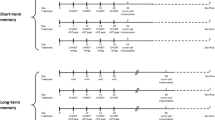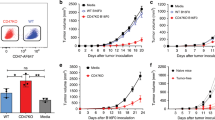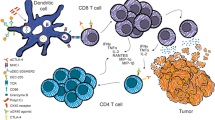Abstract
The low immunogenicity of malignant cells is one of the causes responsible for the lack of antitumor immune responses. Thus, development of new therapeutic strategies aimed at enhancing presentation of tumor antigens to T cells is a main goal of cancer immunotherapy. With this aim, we studied the efficacy of administering adjuvants poly(I:C) and agonistic anti-CD40 antibody plus a tumor antigen. Joint intravenous immunization with these adjuvants and a model tumor antigen (ovalbumin) was able to synergistically induce potent and long lasting antitumor T-cell responses. These responses protected against challenge with E.G7–OVA tumor cells in prophylactic short- and long-term vaccination. In a therapeutic setting, repeated intratumor administration of adjuvants plus antigen was able to reject established tumors in all treated animals, leading in some cases to the rejection of both locally treated and untreated tumors. Antitumor immune responses induced by these protocols were mediated not only by T-cells but also by NK cells. In conclusion, combined administration of adjuvants poly(I:C) and anti-CD40 plus a tumor antigen is an efficient strategy for prophylactic and therapeutic antitumor vaccination.







Similar content being viewed by others
Abbreviations
- OVA:
-
Ovalbumin
- TLR:
-
Toll like receptors
- poly(I:C):
-
Polyinosinic polycytidylic acid
- i.v.:
-
Intravenous
- i.t.:
-
Intratumor
- s.c.:
-
Subcutaneous
References
Abrams SI, Hodge JW, McLaughlin JP, Steinberg SM, Kantor JA, Schlom J (1997) Adoptive immunotherapy as an in vivo model to explore antitumor mechanisms induced by a recombinant anticancer vaccine. J Immunother 20:48–59
Ahonen CL, Doxsee CL, McGurran SM, Riter TR, Wade WF, Barth RJ, Vasilakos JP, Noelle RJ, Kedl RM (2004) Combined TLR and CD40 triggering induces potent CD8+ T cell expansion with variable dependence on type I IFN. J Exp Med 199:775–784
Alexopoulou L, Holt AC, Medzhitov R, Flavell RA (2001) Recognition of double-stranded RNA and activation of NF-kappaB by Toll-like receptor 3. Nature 413:732–738
Banchereau J, Steinman RM (1998) Dendritic cells and the control of immunity. Nature 392:245–252
Bourgeois C, Rocha B, Tanchot C (2002) A role for CD40 expression on CD8+ T cells in the generation of CD8+ T cell memory. Science 297:2060–2063
Casares N, Arribillaga L, Sarobe P, Dotor J, Lopez-Diaz de Cerio A, Melero I, Prieto J, Borras-Cuesta F, Lasarte JJ (2003) CD4+/CD25+ regulatory cells inhibit activation of tumor-primed CD4+ T cells with IFN-gamma-dependent antiangiogenic activity, as well as long-lasting tumor immunity elicited by peptide vaccination. J Immunol 171:5931–5939
Caux C, Massacrier C, Vanbervliet B, Dubois B, Van Kooten C, Durand I, Banchereau J (1994) Activation of human dendritic cells through CD40 cross-linking. J Exp Med 180:1263–1272
Garbi N, Arnold B, Gordon S, Hammerling GJ, Ganss R (2004) CpG motifs as proinflammatory factors render autochthonous tumors permissive for infiltration and destruction. J Immunol 172:5861–5869
Gerard CM, Baudson N, Kraemer K, Bruck C, Garcon N, Paterson Y, Pan ZK, Pardoll D (2001) Therapeutic potential of protein and adjuvant vaccinations on tumour growth. Vaccine 19:2583–2589
Germain RN (1994) MHC-dependent antigen processing and peptide presentation: providing ligands for T lymphocyte activation. Cell 76:287–299
Gitlin L, Barchet W, Gilfillan S, Cella M, Beutler B, Flavell RA, Diamond MS, Colonna M (2006) Essential role of mda-5 in type I IFN responses to polyriboinosinic:polyribocytidylic acid and encephalomyocarditis picornavirus. Proc Natl Acad Sci USA 103:8459–8464
Grosenbach DW, Barrientos JC, Schlom J, Hodge JW (2001) Synergy of vaccine strategies to amplify antigen-specific immune responses and antitumor effects. Cancer Res 61:4497–4505
Heckelsmiller K, Rall K, Beck S, Schlamp A, Seiderer J, Jahrsdorfer B, Krug A, Rothenfusser S, Endres S, Hartmann G (2002) Peritumoral CpG DNA elicits a coordinated response of CD8 T cells and innate effectors to cure established tumors in a murine colon carcinoma model. J Immunol 169:3892–3899
Hock H, Dorsch M, Kunzendorf U, Qin Z, Diamantstein T, Blankenstein T (1993) Mechanisms of rejection induced by tumor cell-targeted gene transfer of interleukin 2, interleukin 4, interleukin 7, tumor necrosis factor, or interferon gamma. Proc Natl Acad Sci USA 90:2774–2778
Hung K, Hayashi R, Lafond-Walker A, Lowenstein C, Pardoll D, Levitsky H (1998) The central role of CD4(+) T cells in the antitumor immune response. J Exp Med 188:2357–2368
Janeway CA, Jr Medzhitov R (2002) Innate immune recognition. Annu Rev Immunol 20:197–216
Jonuleit H, Kuhn U, Muller G, Steinbrink K, Paragnik L, Schmitt E, Knop J, Enk AH (1997) Pro-inflammatory cytokines and prostaglandins induce maturation of potent immunostimulatory dendritic cells under fetal calf serum-free conditions. Eur J Immunol 27:3135–3142
Kato H, Takeuchi O, Sato S, Yoneyama M, Yamamoto M, Matsui K, Uematsu S, Jung A, Kawai T, Ishii KJ, Yamaguchi O, Otsu K, Tsujimura T, Koh CS, Reis e Sousa C, Matsuura Y, Fujita T, Akira S (2006) Differential roles of MDA5 and RIG-I helicases in the recognition of RNA viruses. Nature 441:101–105
Kawarada Y, Ganss R, Garbi N, Sacher T, Arnold B, Hammerling GJ (2001) NK- and CD8(+) T cell-mediated eradication of established tumors by peritumoral injection of CpG-containing oligodeoxynucleotides. J Immunol 167:5247–5253
Koschella M, Voehringer D, Pircher H (2004) CD40 ligation in vivo induces bystander proliferation of memory phenotype CD8 T cells. J Immunol 172:4804–4811
Lefrancois L, Altman JD, Williams K, Olson S (2000) Soluble antigen and CD40 triggering are sufficient to induce primary and memory cytotoxic T cells. J Immunol 164:725–732
Lipford GB, Hoffman M, Wagner H, Heeg K (1993) Primary in vivo responses to ovalbumin. Probing the predictive value of the Kb binding motif. J Immunol 150:1212–1222
Lodolce JP, Boone DL, Chai S, Swain RE, Dassopoulos T, Trettin S, Ma A (1998) IL-15 receptor maintains lymphoid homeostasis by supporting lymphocyte homing and proliferation. Immunity 9:669–676
Mayordomo JI, Zorina T, Storkus WJ, Zitvogel L, Celluzzi C, Falo LD, Melief CJ, Ildstad ST, Kast WM, Deleo AB, Lotze MT (1995) Bone marrow-derived dendritic cells pulsed with synthetic tumour peptides elicit protective and therapeutic antitumour immunity. Nat Med 1:1297–1302
Moore MW, Carbone FR, Bevan MJ (1988) Introduction of soluble protein into the class I pathway of antigen processing and presentation. Cell 54:777–785
Ochsenbein AF (2002) Principles of tumor immunosurveillance and implications for immunotherapy. Cancer Gene Ther 9:1043–1055
Ochsenbein AF, Sierro S, Odermatt B, Pericin M, Karrer U, Hermans J, Hemmi S, Hengartner H, Zinkernagel RM (2001) Roles of tumour localization, second signals and cross priming in cytotoxic T-cell induction. Nature 411:1058–1064
Palena C, Abrams SI, Schlom J, Hodge JW (2006) Cancer vaccines: preclinical studies and novel strategies. Adv Cancer Res 95:115–145
Rieser C, Bock G, Klocker H, Bartsch G, Thurnher M (1997) Prostaglandin E2 and tumor necrosis factor alpha cooperate to activate human dendritic cells: synergistic activation of interleukin 12 production. J Exp Med 186:1603–1608
Rolink A, Melchers F, Andersson J (1996) The SCID but not the RAG-2 gene product is required for S mu-S epsilon heavy chain class switching. Immunity 5:319–330
Rotzschke O, Falk K, Stevanovic S, Jung G, Walden P, Rammensee HG (1991) Exact prediction of a natural T cell epitope. Eur J Immunol 21:2891–2894
Salem ML, El-Naggar SA, Kadima A, Gillanders WE, Cole DJ (2006) The adjuvant effects of the toll-like receptor 3 ligand polyinosinic-cytidylic acid poly (I:C) on antigen-specific CD8+ T cell responses are partially dependent on NK cells with the induction of a beneficial cytokine milieu. Vaccine 24:5119–5132
Sallusto F, Lanzavecchia A (1994) Efficient presentation of soluble antigen by cultured human dendritic cells is maintained by granulocyte/macrophage colony-stimulating factor plus interleukin 4 and downregulated by tumor necrosis factor alpha. J Exp Med 179:1109–1118
Shimonkevitz R, Colon S, Kappler JW, Marrack P, Grey HM (1984) Antigen recognition by H-2-restricted T cells. II. A tryptic ovalbumin peptide that substitutes for processed antigen. J Immunol 133:2067–2074
Sivori S, Falco M, Della Chiesa M, Carlomagno S, Vitale M, Moretta L, Moretta A (2004) CpG and double-stranded RNA trigger human NK cells by Toll-like receptors: induction of cytokine release and cytotoxicity against tumors and dendritic cells. Proc Natl Acad Sci USA 101:10116–10121
Takeda K, Kaisho T, Akira S (2003) Toll-like receptors. Annu Rev Immunol 21:335–376
Tartour E, Ciree A, Haicheur N, Benchetrit F, Fridman WH (2000) Development of non-live vectors and procedures (liposomes, pseudo-viral particles, toxin, beads, adjuvantsellipsis) as tools for cancer vaccines. Immunol Lett 74:45–50
van Mierlo GJ, den Boer AT, Medema JP, van der Voort EI, Fransen MF, Offringa R, Melief CJ, Toes RE (2002) CD40 stimulation leads to effective therapy of CD40(-) tumors through induction of strong systemic cytotoxic T lymphocyte immunity. Proc Natl Acad Sci USA 99:5561–5566
Warger T, Osterloh P, Rechtsteiner G, Fassbender M, Heib V, Schmid B, Schmitt E, Schild H, Radsak MP (2006) Synergistic activation of dendritic cells by combined Toll-like receptor ligation induces superior CTL responses in vivo. Blood 108:544–550
Whitmore MM, DeVeer MJ, Edling A, Oates RK, Simons B, Lindner D, Williams BR (2004) Synergistic activation of innate immunity by double-stranded RNA and CpG DNA promotes enhanced antitumor activity. Cancer Res 64:5850–5860
Zhang X, Sun S, Hwang I, Tough DF, Sprent J (1998) Potent and selective stimulation of memory-phenotype CD8+ T cells in vivo by IL-15. Immunity 8:591–599
Zitvogel L, Mayordomo JI, Tjandrawan T, DeLeo AB, Clarke MR, Lotze MT, Storkus WJ (1996) Therapy of murine tumors with tumor peptide-pulsed dendritic cells: dependence on T cells, B7 costimulation, and T helper cell 1-associated cytokines. J Exp Med 183:87–97
Acknowledgments
This work was supported by grants from Ministerio de Ciencia y Tecnología (SAF2003–04751) to F.B.-C., and by “UTE project CIMA” and Instituto de Salud Carlos III (C03/02) to all authors. A. Zabaleta is recipient of a scholarship from Gobierno de Navarra. The authors thank Dr. I. Melero for his kindly gift of Rag1–/– mice.
Author information
Authors and Affiliations
Corresponding author
Rights and permissions
About this article
Cite this article
Llopiz, D., Dotor, J., Zabaleta, A. et al. Combined immunization with adjuvant molecules poly(I:C) and anti-CD40 plus a tumor antigen has potent prophylactic and therapeutic antitumor effects. Cancer Immunol Immunother 57, 19–29 (2008). https://doi.org/10.1007/s00262-007-0346-8
Received:
Accepted:
Published:
Issue Date:
DOI: https://doi.org/10.1007/s00262-007-0346-8




